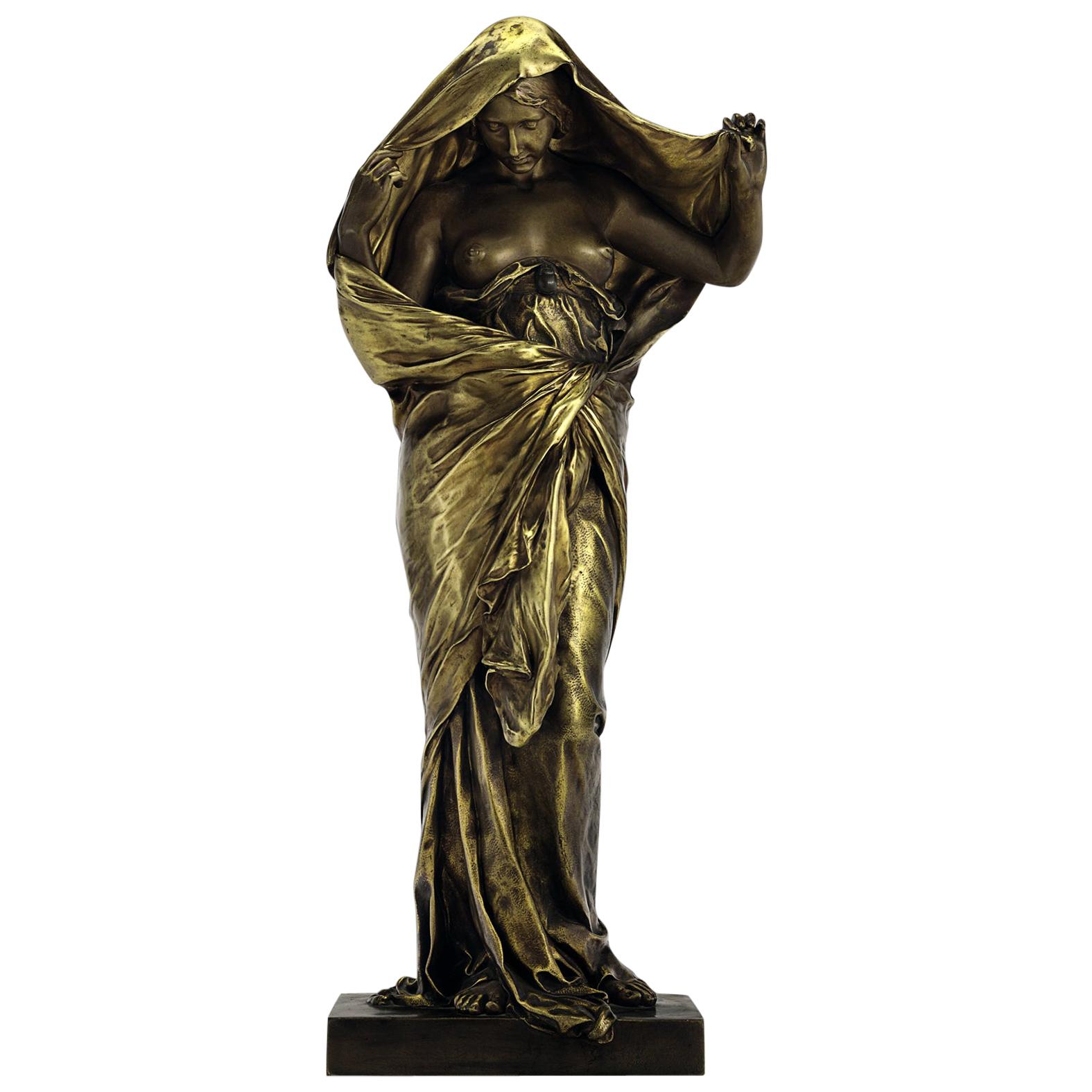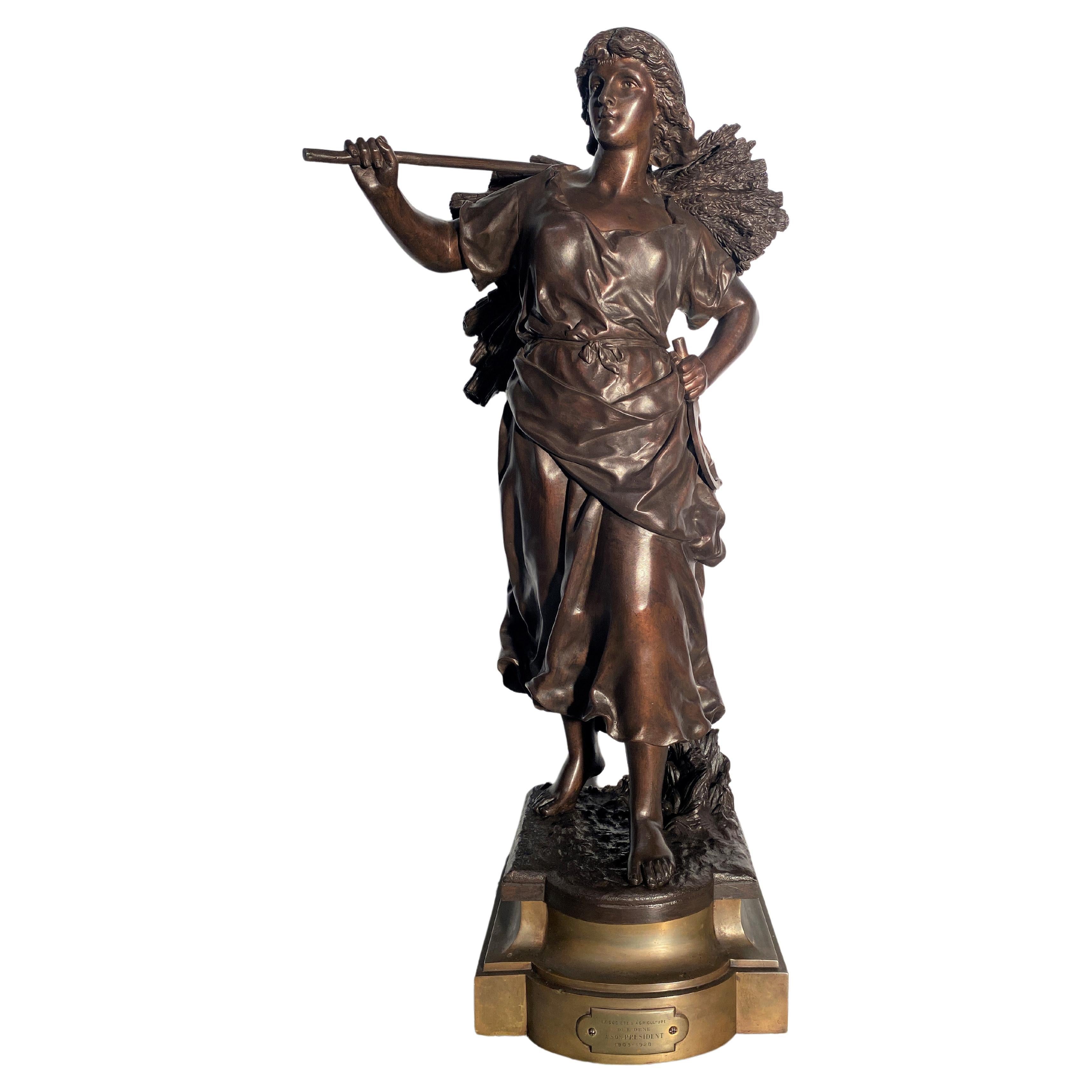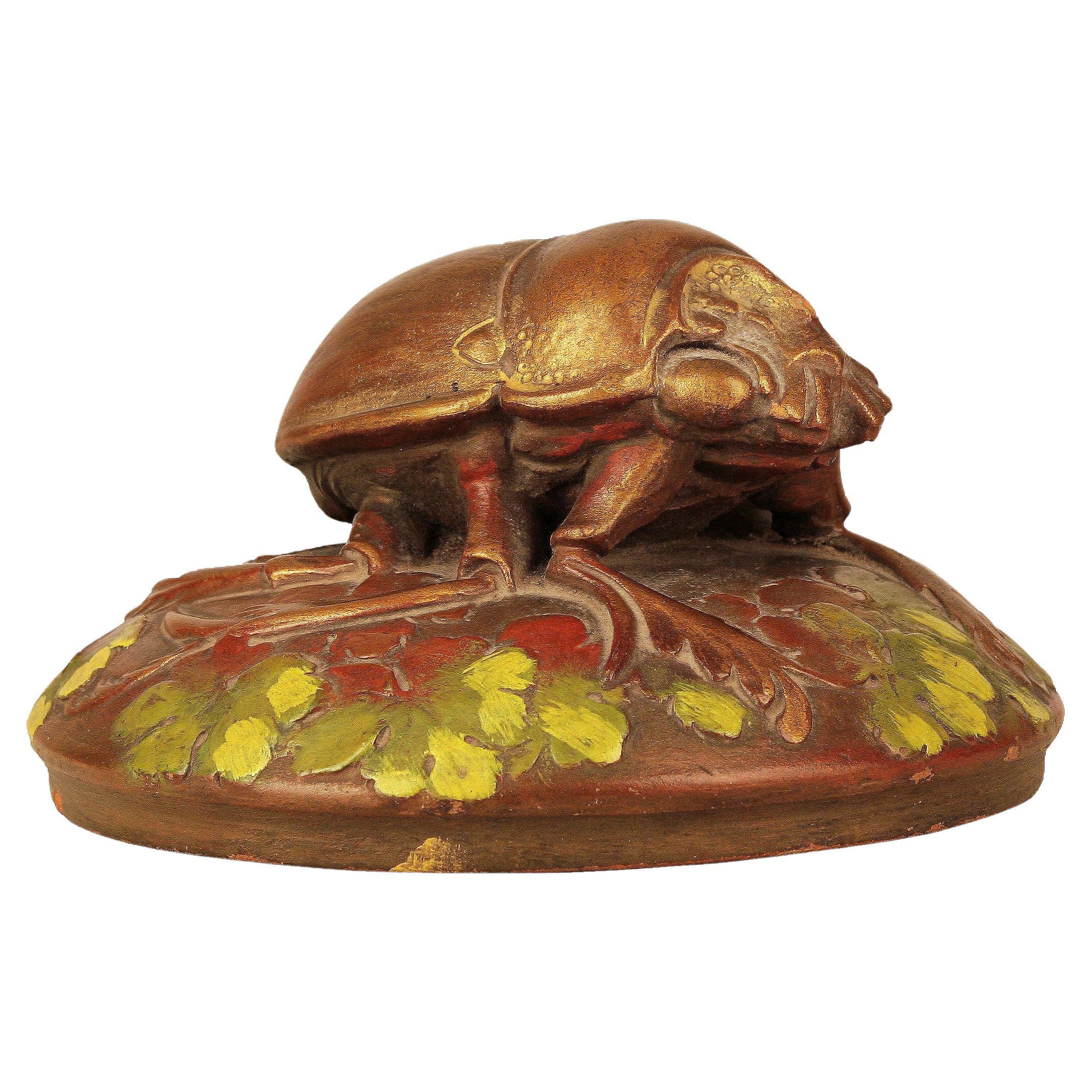Items Similar to 'La Nature se dévoilant devant la Science' by Louis-Ernest Barrias
Want more images or videos?
Request additional images or videos from the seller
1 of 10
'La Nature se dévoilant devant la Science' by Louis-Ernest Barrias
About the Item
'La Nature se dévoilant devant la Science', A Large and Rare Gilt and Silvered Bronze and Marble Figure entitled ('Nature unveiling itself before science') By Louis-Ernest Barrias (French, 1841 – 1905).
'La Nature se dévoilant devant la Science' ('Nature unveiling itself before science')
Silver, Gilt and Patinated bronze. White Marble. Green marble base with pyrite flecks. The scarab beetle broach in lapis lazuli.
Cast as part of a limited edition by the Susse Frères foundry, Paris, from the model by Louis-Ernest Barrias (French, 1841 – 1905). Conceived in 1893/99. This cast Circa 1900.
signed: 'E. Barrias' and with the 'SUSSE FRERES EDITEURS PARIS' foundry stamp above letter 'W'.
France, Circa 1900.
Barrias' most celebrated work, an homage to advances made in scientific exploration, first appeared in marble at the Paris Salon of 1893 by its lengthier title 'La Nature mystérieuse et voil se découvre devant la Science' (no. 2543) and was fittingly acquired by the faculty at l'Ecole de Médecine in Bordeaux. This first version was entirely nude apart from the veil which hung over her head and fell to her toes. Barrias presented a reduced and edited version of this subject, partly clothed like the present example, at the Salon of 1899 simply titled 'La Nature se dèvoilant' (no. 3186). Executed in polychrome marble and Algerian onyx it stands two meters high and was intended for the main staircase of the Conservatoire des Arts et Métiers in Paris. It was acquired by the French state and displayed at Musée du Luxemburg from 1903 and moved to the musée d'Orsay in 1986 (inventory number RF 1409).
The female nude conveys the symbolism of nature reflecting the revelations of natural science as discovered through scientific advancements, with exposed breasts being a symbol of nature in allegorical figures from the Renaissance. Accusations of coquettish intentions, at the time and since, rather miss this point, but still and undeniably, the subject “testifies to a sense of beauty, entirely personal and expressive of dreams common to so many men, that will long provide in those who contemplate it a feeling of tenderness” (G. Mourey, ‘Ernest Barrias’, Les Arts, No. 40, April 1905., p. 32.).
The first bronze casts exhibited by Susse were shown to great critical acclaim at the 1900 Exposition Universelle. At the Liège Exhibition of 1905, the renowned bronzier Théodore Millet deemed the model a tour de force for the Susse firm, proclaiming “La Nature se dévoilant devant la Science by the late Ernest Barrias can be considered the most beautiful of the works on display; it also won a Grand Prize for MM. Susse Frères” (Exposition Universelle & Internationale de Liège 1905, Section Française, Classe 97, Rapport Par M. Th. Millet, Comité Français des Exposition à L’Étranger, Paris, 1907, p. 14).
The foundry Susse Frères cast the bronze in five different sizes (97, 73, 58, 43, and 24 cm high) and with a variety of patinas, sometimes with the inclusion of marble for the face, upper body, and feet. The use of gold, silver and precious materials adds to the sense of opulence typical of the fin-de-siècle. The complexity of the reduction process employed to make the Susse Frères editions, as well as the use of multicoloured patinas also speaks to the sense of scientific advancement embodied by Nature unveiling itself before science. As noted in the catalogue for the exhibition The Colour of Sculpture, held in 1996 at the Van Gogh Museum in Amsterdam and the Henry Moore Institute in Leeds, the sculpture itself is a symbol of technological advancement: “Breathtaking technical progress seemed to solve all the mysteries of the world, and it appeared only a matter of time before—to use Barrias’s visual language—nature revealed its last secrets. That such […] academic female figures could still be employed at the beginning of the age of electricity is characteristic for the nineteenth-century, with its usual simultaneity of heterogeneous forms of expression.” (A. Blühm, The Colour of Sculpture, 1840-1910 [Amsterdam: Van Gogh Museum; Leeds: Henry Moore Institute; Zwolle: Waanders Uitgevers, 1996], p.186).
The present bronze measures 97 cm. high and is a rare example of the largest size cast by Susse Frères and incorporating white marble for the bust. Examples of the smaller size appear more frequently on the market, but this largest size is rare. A much smaller Susse Frères reduction of 'La Nature se dévoilant devant la Science', measuring 58 cm. high, is in the collection of the National Gallery of Art, Washington D.C., USA (Accession No. 2004.166.1).
On a Pink Breccia Marble Pedestal.
Dimensions:
Height : 97 cm 38 inches
Width : 45 cm 18 inches
Depth : 27 cm 11 inches
Weight : 66 kg 145
Dimensions of Marble Pedestal:
Height: 111 cm 44 inches
Width: 38 cm 15 inches
Depth: 38 cm 15 inches
Total Height including pedestal:
208 cm 82 inches
- Creator:Louis Ernest Barrias (Sculptor)
- Dimensions:Height: 81.89 in (208 cm)Width: 17.72 in (45 cm)Depth: 10.63 in (27 cm)
- Style:Belle Époque (Of the Period)
- Materials and Techniques:
- Place of Origin:
- Period:
- Date of Manufacture:Circa 1900
- Condition:Wear consistent with age and use.
- Seller Location:Brighton, GB
- Reference Number:
About the Seller
5.0
Recognized Seller
These prestigious sellers are industry leaders and represent the highest echelon for item quality and design.
Established in 1964
1stDibs seller since 2014
48 sales on 1stDibs
Typical response time: 1 hour
Associations
The British Antique Dealers' AssociationLAPADA - The Association of Arts & Antiques Dealers
- ShippingRetrieving quote...Ships From: Brighton, United Kingdom
- Return PolicyA return for this item may be initiated within 7 days of delivery.
More From This SellerView All
- Bronze Figure of 'La Nature Se Dévoilant Devant La Science'By Louis Ernest BarriasLocated in Brighton, West SussexBronze figure of 'La Nature se dévoilant devant la Science' by Louis-Ernest Barrias. Inscribed 'E. Barrias' and with Susse Frères foundry cachet and further Susse inscription. ...Category
Early 20th Century French Figurative Sculptures
MaterialsBronze
- Bronze Figure of Jeanne d'Arc From The Model By Louis Ernest BarriasBy Louis Ernest BarriasLocated in Brighton, West SussexA Large Patinated Bronze Figure of ‘Jeanne d'Arc Prisonnière’ (‘Prisoner Joan of Arc’), By Louis-Ernest Barrias (French, 1841–1905). Joan of Arc modelled standing, in handcuffs and armour and wearing a Bascinet helmet. Signed ‘E. Barrias’ and with foundry mark ‘Susse Fres Edit Paris', Stamped 'PS'. Titled on the base: ‘Vous avez pu m'enchainer/vous n'enchainerez jamais la Fortune de la France/Jeanne d'Arc’ ('You were able to chain me but you will never chain the will of France. Joan of Arc’). Cast as part of a limited edition by the Susse Frères foundry, Paris, from the model by Louis-Ernest Barrias (French, 1841 – 1905). The model conceived Circa 1891 and Cast Circa 1910. In 1891 Barrias completed his touching life-size portrait of 'Jeanne d'Arc devant ses judges' ('Joan of Arc before the judges') in marble for her monument at the Church...Category
Antique 19th Century French Figurative Sculptures
MaterialsBronze
- 'La Tuffolina', a Marble Group of a Diving Girl by Odoarda Tabacchi, circa 1880By Odoardo TabacchiLocated in Brighton, West Sussex'La Tuffolina' - an important white marble group of a diving girl on a naturalistic base, by Odoarda Tabacchi Italian, circa 1880. Signed 'O.Tabacchi/Torino'. This Fine marble group depicts a graceful young girl wearing a knitted bathing dress, her hair held in a chignon with her arms raised above her head in a diving position, standing on the edge of a natural POOL, with the waves lapping behind her. This charming and dynamic figure, full of natural grace proved to be one of Tabacchi's most popular sculptures and was edited in a number of sizes in both bronze and marble. First exhibited in marble at the Esposizione d'arte di Napoli del 1877, it was reportedly purchased by King Vittorio Emanuele II and illustrated in L'Illustrazione Italiana, No 23, June 10, 1877, in an engraving based on a sketch by Michetti. It was subsequently exhibited with great acclaim at the 1878 Paris Exposition Universelle and examples were also produced in ceramic, including Parian ware examples by the English firm of Robinson & Leadbenton. A comparative marble version is in the collection of the Museo di Capodimonte, Naples. Odoardo Tabacchi...Category
Antique Late 19th Century Italian Art Nouveau Figurative Sculptures
MaterialsMarble
- Pair of Patinated Bronze Egyptian Figures by Emile Louis PicaultBy Émile Louis PicaultLocated in Brighton, West SussexA Pair of Patinated Bronze Figures Of The Egyptian High Priest 'Pastophore' and The Egyptian Scribe 'Hierogrammate' By Emile Louis Picault (French, 1833-1915). Each signed 'Picau...Category
Antique 19th Century French Egyptian Revival Figurative Sculptures
MaterialsBronze
- Pair of Patinated Bronze Figures by Émile Louis Picault, circa 1890By Émile Louis PicaultLocated in Brighton, West SussexA fine pair of patinated bronze figures of an archer and a scholar by Émile Louis Picault. French, circa 1890. Cast signature to each ba...Category
Antique Late 19th Century French Figurative Sculptures
MaterialsBronze
- Patinated Bronze Allegorical Busts of Autumn and Summer By Pierre-Louis DétrierBy Pierre-Louis Detrier 1Located in Brighton, West SussexA Fine Pair of Patinated Bronze Allegorical Busts of Autumn and Summer By Pierre-Louis Détrier. Finely modelled and cast, the busts depict young maidens allegorical of Summer and Au...Category
Antique 19th Century French Busts
MaterialsGranite, Bronze, Ormolu
You May Also Like
- Unique Cire Perdue Gilt Bronze Sculpture of Roses by Louis Ernest BarriasBy Louis Ernest BarriasLocated in Philadelphia, PAA unique Cire Perdue gilt bronze sculpture of roses by Louis Ernest Barrias. The singular lost wax cast of a still life of roses is mounted on a rosewoo...Category
Antique Late 19th Century French Beaux Arts Figurative Sculptures
MaterialsBronze
- "La Moissonneuse" Statue en Bronze Par Ernest RancouletBy RancouletLocated in VERSAILLES, FRImportant bronze sculpture with brown patina representing a young woman harvester returning from work in the fields. Note the beautiful expression of the face underlining the satisfa...Category
Early 20th Century French Art Nouveau Figurative Sculptures
MaterialsBronze
- Fine Bronze Figures Entitled "Reveil de La Nature" by E. PicaultLocated in New York, NYArtist: Emile Louis Picault (1833–1915) Origin: French Date: Late 19th century Dimension: 34 1/2 x 17 inches.Category
Antique 19th Century French Figurative Sculptures
MaterialsBronze
- Early 20th Century French Cold-Painted Ceramic Beetle Sculpture by Ernest DuboisBy Ernest DuboisLocated in North Miami, FLEarly 20th century french cold-painted had-crafted ceramic beetle sculpture by Ernest Dubois By: Ernest Dubois Material: ceramic, paint Technique: cast, pressed, painted, hand-paint...Category
Early 20th Century French Belle Époque Animal Sculptures
MaterialsPaint, Ceramic
- Emile Louis Picault, Bronze Statue, Titled La Pensee, France, 1900sBy Émile Louis PicaultLocated in Stamford, CTLa Pensee By E. Picault Bears Foundry Mark 19c Bronze The winged youth clad in billowing drape and taking flight with one hand raised, incised E. PICAULT, title plaque LA PENSÉE prenant son envol et portant la lumière, E. Picault. Émile Louis Picault was a prolific French Orientalist sculptor known for his bronzes depicting allegorical and mythological scenes. Picault often chose warriors and heroes as subjects, as seen in his La Défense Du Foyer (ca. 1890), which extols patriotic virtues in French. Born on August 24, 1833 in Paris, France he studied under the painter Henri Royer...Category
Antique Late 19th Century French Belle Époque Figurative Sculptures
MaterialsBronze
- Opalescent Art Glass Fish Figurine by Marius-Ernest SabinoBy Marius-Ernest SabinoLocated in Miami, FLSabino's small collectable works, beautifully executed with great detail. Opalescent glass and signed on base "Sabino France". Of the "Art Deco" period Sabino art glass refers to...Category
Early 20th Century French Art Deco Animal Sculptures
MaterialsArt Glass





